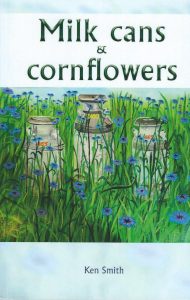 The poems in Ken Smith’s collection, Milk cans & cornflowers, show a love of language that rises above workmanlike prose. The author lets readers experience walks along the St. Lawrence River; shares some of his past, points out striking objects or phenomena, and acknowledges the importance of family, including the “family” of great poets and writers of the past.
The poems in Ken Smith’s collection, Milk cans & cornflowers, show a love of language that rises above workmanlike prose. The author lets readers experience walks along the St. Lawrence River; shares some of his past, points out striking objects or phenomena, and acknowledges the importance of family, including the “family” of great poets and writers of the past.
A review of Earlier by Sasha Frere-Jones
 I also really wished that that was going to create a clearing in the critical discourse in which I could discuss the Situationists, among other Francophile souvenirs I’ve collected over the years. Afterall, “Greil Marcus, Lipstick Traces” is the last bit of language on the back cover. Possibility of a backdoor?
I also really wished that that was going to create a clearing in the critical discourse in which I could discuss the Situationists, among other Francophile souvenirs I’ve collected over the years. Afterall, “Greil Marcus, Lipstick Traces” is the last bit of language on the back cover. Possibility of a backdoor?
A review of Strange Meadowlark by Michael Simms
 The music of the poems is suffused by a nuance of idiosyncrasies that leaves one having to learn how to read them, stopping and starting occasionally. But these reveal themselves as integral to the themes. For instance, there’s a conspicuous absence of periods.
The music of the poems is suffused by a nuance of idiosyncrasies that leaves one having to learn how to read them, stopping and starting occasionally. But these reveal themselves as integral to the themes. For instance, there’s a conspicuous absence of periods.
The Archaeology of Memoir: A review of It’s No Puzzle: A Memoir in Artifact by Cris Mazza
 It’s No Puzzle: A Memoir in Artifact was a challenge to write and assemble with its vast cache of memorabilia. The publisher, Spuyten Duyvil Press, did an exemplary job of logistically formatting the book to its polished result. What Mazza uncovers explains her challenges even if it doesn’t quite resolve them.
It’s No Puzzle: A Memoir in Artifact was a challenge to write and assemble with its vast cache of memorabilia. The publisher, Spuyten Duyvil Press, did an exemplary job of logistically formatting the book to its polished result. What Mazza uncovers explains her challenges even if it doesn’t quite resolve them.
A review of Edith Wharton’s The House of Mirth
 As a protagonist, Lily is not easy to love. She isn’t down to earth and feisty like a Jane Austen heroine or destitute and virtuous like one of Thomas Hardy’s. She is vain, materialistic, and small-minded. She obsesses over clothes, incomes, and table settings, and is cruel to the friends whose modest means render them socially useless to her.
As a protagonist, Lily is not easy to love. She isn’t down to earth and feisty like a Jane Austen heroine or destitute and virtuous like one of Thomas Hardy’s. She is vain, materialistic, and small-minded. She obsesses over clothes, incomes, and table settings, and is cruel to the friends whose modest means render them socially useless to her.
A review of Transcript of the Disappearance, Exact and Diminishing by Lynn Emanuel
 In what may be in the voice of the Coronavirus talking to the poet, she writes in “Plague’s Monologue,”: “I erased the world so nothing can find it…” and concludes the piece, “…there is no limit to my appetite, my lust, my zeal for emptiness. But I know you—and you have kept a transcript of the disappearance.”
In what may be in the voice of the Coronavirus talking to the poet, she writes in “Plague’s Monologue,”: “I erased the world so nothing can find it…” and concludes the piece, “…there is no limit to my appetite, my lust, my zeal for emptiness. But I know you—and you have kept a transcript of the disappearance.”
A review of Bleedings by Gabriele Tinti
 Poetry is this ability to transcend, to cross through the masks that feed the comedy, living bulimically on illusions; it is looking beyond what appears, entering the shadow, listening to the unspeakable until the original silence while keeping the wound always open because we need to be there, close to the blade,/ at the mercy of pain, letting that blood, which is life, flow. Hence, bleeding as an opening, as the only possibility of existence.
Poetry is this ability to transcend, to cross through the masks that feed the comedy, living bulimically on illusions; it is looking beyond what appears, entering the shadow, listening to the unspeakable until the original silence while keeping the wound always open because we need to be there, close to the blade,/ at the mercy of pain, letting that blood, which is life, flow. Hence, bleeding as an opening, as the only possibility of existence.
A review of Balmain Contemplations by Noel Jeffs
 This system of imagery is woven with religious associations of annunciation or resurrection, but with an innocent freshness that removes too much knowingness or didactic artifice. The quote on the back cover is Proust’s observation that the real voyage of discovery is not travelling but seeing newly. One should observe at this point that to see something as if for the first time is not the same as seeing it once again differently, and that these two things have a separate poetic function.
This system of imagery is woven with religious associations of annunciation or resurrection, but with an innocent freshness that removes too much knowingness or didactic artifice. The quote on the back cover is Proust’s observation that the real voyage of discovery is not travelling but seeing newly. One should observe at this point that to see something as if for the first time is not the same as seeing it once again differently, and that these two things have a separate poetic function.
A review of One River by Steve Armstrong
 Haibun is the perfect form for these reflections, combining prose and poetry to create a work that is both descriptive/educational and deeply intimate. Armstrong has replaced the traditional Haiku of Haibun with the Korean Sijo which allows for double the line length and extra syllables, with a focus on the rich nature of the spaces he’s inhabiting. The result is quite beautiful, inviting the reader to join in both the descriptive amble and the poetic pauses of the Sijo creating a space for connection.
Haibun is the perfect form for these reflections, combining prose and poetry to create a work that is both descriptive/educational and deeply intimate. Armstrong has replaced the traditional Haiku of Haibun with the Korean Sijo which allows for double the line length and extra syllables, with a focus on the rich nature of the spaces he’s inhabiting. The result is quite beautiful, inviting the reader to join in both the descriptive amble and the poetic pauses of the Sijo creating a space for connection.
A review of The Iliad translated by Emily Wilson
 In summary, Emily Wilson’s translation of The Iliad is a tour de force that navigates the fine line between faithfulness to the original and contemporary relevance. While some critics accuse her of excessive modernization, these criticisms often overlook her intent: to make this epic tale accessible to a broader audience without sacrificing its original integrity.
In summary, Emily Wilson’s translation of The Iliad is a tour de force that navigates the fine line between faithfulness to the original and contemporary relevance. While some critics accuse her of excessive modernization, these criticisms often overlook her intent: to make this epic tale accessible to a broader audience without sacrificing its original integrity.